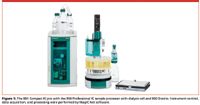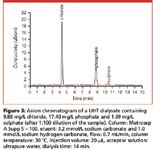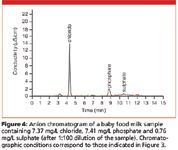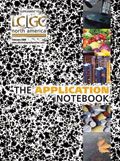Analysis of Food Samples with Ion Chromatography After In-line Dialysis
Run a difficult food sample on your IC and you stand a big chance that you will wreck the column. Of course, you can waste a lot of time on tedious sample preparation steps to eliminate undesired matrix components. Or you can go for Metrohm's automated compact stopped-flow dialysis providing optimum separation while protecting your column from detrimental compounds.
Run a difficult food sample on your IC and you stand a big chance that you will wreck the column. Of course, you can waste a lot of time on tedious sample preparation steps to eliminate undesired matrix components. Or you can go for Metrohm's automated compact stopped-flow dialysis providing optimum separation while protecting your column from detrimental compounds.
Ion chromatography (IC) as an analytical technique has experienced an impressive surge in popularity because of the simplicity and robustness of the method, the improved reliability, and the great choice of columns, detectors, and applications. For a sample in a homogeneous matrix, very little sample preparation is required and results can be obtained within a matter of minutes. In complex matrices carrying high organic loads such as wastewater, soil eluates, or dairy products, a more extensive sample preparation is mandatory to prevent destruction of the column.
Although numerous sample preparation techniques have been developed, such as the Carrez precipitation for protein-containing samples, most of them are tedious and error-prone. To overcome these shortcomings, Metrohm launched the first coupling of IC with dialysis in 1997. Since then the procedure has been further improved and allows for an efficient in-line elimination of undesired matrix components in a variety of demanding sample types.
Using, as examples, an ultra-high temperature (UHT) processed milk and a baby milk powder sample, this work presents a fully automated sample preparation set-up coupled to the new ion chromatograph 881 Compact IC pro. Calibration parameters, carryover, and recovery rates were tested with multi-anion standards.
Materials and Methods
Instrumentation
- 881 Compact IC pro
- 858 Professional IC sample processor
- 800 Dosino
- Dialysis equipment
Reagents and Eluents
All standard solutions and eluents were prepared with deionized water having a specific resistance higher than 18 MΩ.cm. Two standard solutions covering the concentration ranges 1.0...3.6 mg/L and 10...36 mg/L served to determine the system characteristics.
The ultra-high temperature (UHT) processed milk and the baby milk powder were purchased from Migros, Switzerland.
Compact Stopped-Flow Dialysis
Dialysis is based on the selective diffusion of molecules or ions from one liquid (donor or sample solution) to another (acceptor solution) via a membrane. The driving force for the transfer is the concentration gradient across the membrane. Contrary to dynamic dialysis, where two solutions continuously pass through the dialysis module, at least one solution is temporarily stopped until the concentration in the acceptor solution is the same as that in the donor solution. This patented stopped-flow procedure takes between 10 and 14 min and can be directly coupled to an IC set-up. As the dialysis is performed during the recording of the previous sample's chromatogram, the overall analysis time is not prolonged.

Figure 1
Whereas, in the conventional set-up two 2-channel peristaltic pumps transport the sample and the acceptor solution to and from the dialysis cell, in compact dialysis a Dosino doses ultrapure water through the acceptor compartment of the cell. The stopped-flow status is achieved by stopping the Dosino and blocking the outlet capillary of the cell by feeding it through the valve of the sample processor. The latter, depending on its valve position, allows or blocks the acceptor solution flow.

Figure 2
System Characterisitcs
Calibration
Five concentration levels (0.5, 1, 5, 10 and 20 mg/L) prepared from a multi-ion standard were used for external calibration.
Carryover
Carryover was evaluated by injection of a blank (ultrapure water) immediately after injection of a standard.
Recovery rates
To determine recovery rates, results obtained by direct injection were compared to those obtained by injection of the dialysate.
Dairy Samples
UHT processed milk
Prior to analysis, the UHT processed milk sample was diluted 1:100 with ultrapure water and placed in the sample vials upon the rack of the sample processor. The subsequent dialysis of the milk sample and the injection of the dialysate onto the separation column was fully automated. The calculation was performed automatically using integration software MagIC Net 1.1 against the previously prepared calibration plots (see section "Calibration").
Under the conditions described in the caption of Figure 3, excellent baseline separation of chloride, phosphate, and sulphate is achieved within 12 min. Repetitive analyses showed no trending in peak areas or retention times, which suggests that sample proteins did not pass the membrane.

Figure 3
Baby food milk powder
Following the manufacturer's instructions, the baby food milk powder was replenished with water. Prior to analysis, the prepared milk sample was diluted 1:100.

Figure 4
As with the UHT milk sample, also here the chromatographic conditions applied provide an excellent baseline separation for chloride, phosphate, and sulphate.
Conclusion
The analytical challenge treated in the present work consists in the determination of chloride, phosphate, and sulphate in the presence of difficult sample matrices that interact with the stationary column phase or even render it unusable. Metrohm's patented stopped-flow dialysis coupled to the new 881 Compact IC pro ion chromatograph overcomes these drawbacks.
Two standard solutions covering the concentration ranges 1.0...3.6 mg/L and 10...36 mg/L as well as two samples, an ultra-high temperature (UHT) processed milk and a baby milk powder, were characterized in terms of analyte concentration, relative standard deviation, calibration quality, carryover, and recovery rates. While the five-point calibration curves yielded correlation coefficients (R) better than 0.9999, carryover between two subsequent injections of a concentrated sample and a blank was less than 0.49%. Recoveries for the low (1.0...3.6 mg/L) and high standard concentrations (10...36 mg/L) were within 91...99% and 94...100%, respectively.
Automated compact stopped-flow dialysis is a highly efficient sample preparation technique that ensures optimum separation performance by protecting the column from detrimental matrix compounds.
References
(1) Metrohm Application Notes AN-S-044, AN-S-162, AN-N-018, AN-C-100 and AN-C-028, (downloadable under http://products.metrohm.com).
(2) Metrohm Monograph: Sample preparation techniques for ion chromatography, Metrohm AG, Herisau, Switzerland, 108 pages, 8.025.5003.
(3) A. Steinbach and A. Wille, Food Engineering & Ingredients, ,33–36 (2008).
Metrohm International Headquarters
CH-9101 Herisau, Switzerland
tel. +41 71 353 85 04
Email: aw@metrohm.com; Website: www.metrohm.com

Detecting Hyper-Fast Chromatographic Peaks Using Ion Mobility Spectrometry
May 6th 2025Ion mobility spectrometers can detect trace compounds quickly, though they can face various issues with detecting certain peaks. University of Hannover scientists created a new system for resolving hyper-fast gas chromatography (GC) peaks.
Analytical Challenges in Measuring Migration from Food Contact Materials
November 2nd 2015Food contact materials contain low molecular weight additives and processing aids which can migrate into foods leading to trace levels of contamination. Food safety is ensured through regulations, comprising compositional controls and migration limits, which present a significant analytical challenge to the food industry to ensure compliance and demonstrate due diligence. Of the various analytical approaches, LC-MS/MS has proved to be an essential tool in monitoring migration of target compounds into foods, and more sophisticated approaches such as LC-high resolution MS (Orbitrap) are being increasingly used for untargeted analysis to monitor non-intentionally added substances. This podcast will provide an overview to this area, illustrated with various applications showing current approaches being employed.
Automated Sample Preparation (ISO 20122) for MOSH/MOAH in Seasoning Oils
May 6th 2025This work presents an Automated Sample Preparation procedure for MOSH/MOAH analysis of Seasoning Oils. We compare results from a manual epoxidation procedure compliant with DIN 16995 with results based on fully automated sample preparation (epoxidation and saponification) compliant with ISO 20122. In both cases, online clean-up via activated aluminum oxide (AlOx) are used to remove interfering n-alkanes from the MOSH fraction during the HPLC run. Automated data evaluation using a dedicated software (GERSTEL ChroMOH) is presented.

.png&w=3840&q=75)

.png&w=3840&q=75)



.png&w=3840&q=75)



.png&w=3840&q=75)




















